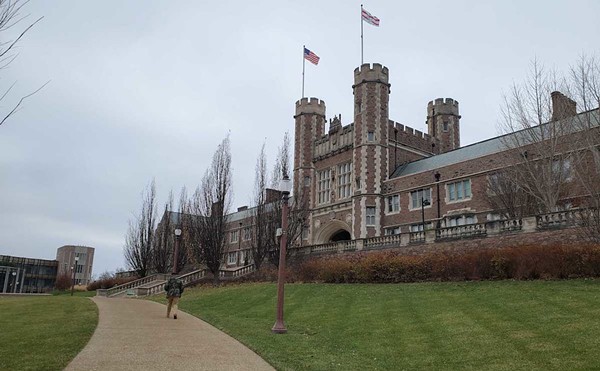South Grand Boulevard is about to undergo a $3 million facelift. Starting this month and lasting until spring of 2011 as part of the "Great Streets" initiative, a six block stretch from Arsenal to Humphrey Street will get new rain-absorbing sidewalks, trees, planter boxes, bike racks, benches, crosswalks, lighting, synchronized traffic lights and more.
And by more, we mean an art project that will "enhance pedestrian's awareness of the effects of motion parallax on their understanding of space and distance."
What exactly does that mean?
The art is by St. Louis native Ben Fehrmann, and it is a series of twelve plain steel panels, mounted upright on bases and located in new "bump outs" that will be installed at intersections along South Grand.
The panels range in size from four-feet-by-eight-inches to six-feet-by-one-foot, but the allure lies in the fact that they will be strategically placed so that no matter where you stand on the street, all the panels will appear to be the same size. Here's a video that tries to convey that idea in a studio mock-up (For more details, see below for Fehrmann's project proposal in .pdf form.)
The panels will be located in new intersection "bump outs" that are intended to narrow the streets, slowing traffic and making it easier for pedestrians to cross.
Rachel Witt, executive director of the South Grand Community Improvement District, explains that to test the bump outs, the organization installed the "parking pots," which were decorated with stencils by artist Peat Wollaeger. When the new bump outs are installed, the parking pots will be gone for good, replaced by the high-concept steel panels.
"The reason why we loved this artist is that you're not going to stare at the ground," Witt explains, noting that panels were chosen over a sidewalk mural after a call for artists went out earlier this year. "We want people to take in the architecture and you notice this by walking instead of looking down. It's a 'Who wants to look down at the sidewalk?' type of thing. We asked him to create a little plaque to put next to each piece so people can understand it."
With their plain faces and high-visibility, it seems likely that the panels will be a magnet for graffiti and vandalism. As a result, the artist notes that each panel will be slathered with "multiple clear coat layers" and "thoroughly waxed," so that they can be easily cleaned. They are said to be durable enough to serve as hitching posts for bicycles, but the artist notes that he's making a few back-ups just in case "a panel is irreparably damaged by a wayward bus."
Ben Fehrmann
South Grand Getting An Extreme Makeover and Some Unusual Street Art
[
{
"name": "GPT - Leaderboard - Inline - Content",
"component": "41932919",
"insertPoint": "5th",
"startingPoint": "3",
"requiredCountToDisplay": "3",
"maxInsertions": 100
}
]





